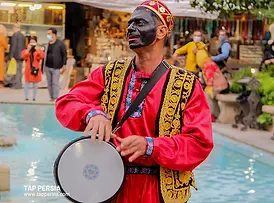Nowruz Characters
Amu Nowruz and Nane Sarma
"Uncle Nowruz" and "Grandma Frost"
Amu Nowruz is the character of a jolly old man much like Santa Claus. He is said to visit on the eve of Nowruz and grant wishes and presents to children while passing on the old stories of Nowruz to the youth. He is also the husband of Nane Sarma.
Nane Sarma is the wife of Amu Nowruz, and her name translates to "Grandma frost" or "Lady Winter" for her role in Iranian folklore as the summoner of the cold winter months.
Both Amu Nowruz and Nane Sarma are part of a classic Iranian folktale in which on the last day of winter, before the spring equinox, Nane Sarma is busily preparing for the arrival of spring (Amu Nowruz). She cleans the house, plants seeds, prepares a Haft-Sin, and prays for a healthy bountiful new year; when she is done she puts on her finest handmade clothes and waits on her porch eating nuts and dried fruit, waiting for her love to return. Slowly she falls asleep, and a short while later Amu Nowruz arrives; he sees his love sleeping peacefully and does not wish to wake her. He realizes he must go spread the message of spring and cannot stay more than a few minutes, so he leaves her gifts and kisses her once on both cheeks before leaving to circle around the Earth once more.
When Nane Sarma wakes she realizes she has missed her chance again and sheds a tear; as she wakes up she sees the gifts from Amu Nowruz and realizes that he did come to visit her. She then returns to her bed, still tired, to slumber until it is time for her to summon the cold winds again.

Haji Firuz
Haji Firuz is arguable the most well known characters in Iranian folk culture. His main purpose is to entertain people around the time of Nowruz by telling stories and singing humorous short and catchy songs.
What is most striking about Haji Firuz is his appearance. His face is blackened, something that has generated questions to the origins of the character, and he can most often be seen wearing bright red.
Many argue that Haji Firuz is not a racist caricature, and is instead a depiction of a god who ventured into the underworld to rescue his wife, or a Zoroastrian priest tending to an eternal flame, or simply that his face is covered in soot from jumping over the Chaharshanbe Suri flames. But evidence suggests that the appearance of Haji Firuz coincide with the popularity of Iranian minstrel shows (called Siyah-bazi or "playing black") during Iran's long history of slavery. It is important to note that much of the effort to rewrite or erase the history of Haji Firuz is the result of the anti-American politics of the Islamic Regime; much of the rhetoric expressed by leaders of the Islamic regime uses the United States' history of slavery as a tool to boast of Iranian superiority and lack of racism, and blatantly ignores Iran's own history of enslavement of Africans.

